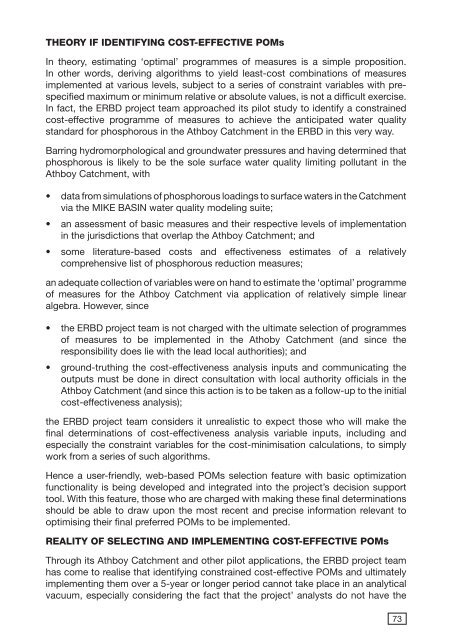Download as a PDF - CiteSeerX
Download as a PDF - CiteSeerX
Download as a PDF - CiteSeerX
Create successful ePaper yourself
Turn your PDF publications into a flip-book with our unique Google optimized e-Paper software.
THEORY IF IDENTIFYING COST-EFFECTIVE POMs<br />
In theory, estimating ‘optimal’ programmes of me<strong>as</strong>ures is a simple proposition.<br />
In other words, deriving algorithms to yield le<strong>as</strong>t-cost combinations of me<strong>as</strong>ures<br />
implemented at various levels, subject to a series of constraint variables with prespecified<br />
maximum or minimum relative or absolute values, is not a difficult exercise.<br />
In fact, the ERBD project team approached its pilot study to identify a constrained<br />
cost-effective programme of me<strong>as</strong>ures to achieve the anticipated water quality<br />
standard for phosphorous in the Athboy Catchment in the ERBD in this very way.<br />
Barring hydromorphological and groundwater pressures and having determined that<br />
phosphorous is likely to be the sole surface water quality limiting pollutant in the<br />
Athboy Catchment, with<br />
• data from simulations of phosphorous loadings to surface waters in the Catchment<br />
via the MIKE BASIN water quality modeling suite;<br />
• an <strong>as</strong>sessment of b<strong>as</strong>ic me<strong>as</strong>ures and their respective levels of implementation<br />
in the jurisdictions that overlap the Athboy Catchment; and<br />
• some literature-b<strong>as</strong>ed costs and effectiveness estimates of a relatively<br />
comprehensive list of phosphorous reduction me<strong>as</strong>ures;<br />
an adequate collection of variables were on hand to estimate the ‘optimal’ programme<br />
of me<strong>as</strong>ures for the Athboy Catchment via application of relatively simple linear<br />
algebra. However, since<br />
• the ERBD project team is not charged with the ultimate selection of programmes<br />
of me<strong>as</strong>ures to be implemented in the Athoby Catchment (and since the<br />
responsibility does lie with the lead local authorities); and<br />
• ground-truthing the cost-effectiveness analysis inputs and communicating the<br />
outputs must be done in direct consultation with local authority officials in the<br />
Athboy Catchment (and since this action is to be taken <strong>as</strong> a follow-up to the initial<br />
cost-effectiveness analysis);<br />
the ERBD project team considers it unrealistic to expect those who will make the<br />
final determinations of cost-effectiveness analysis variable inputs, including and<br />
especially the constraint variables for the cost-minimisation calculations, to simply<br />
work from a series of such algorithms.<br />
Hence a user-friendly, web-b<strong>as</strong>ed POMs selection feature with b<strong>as</strong>ic optimization<br />
functionality is being developed and integrated into the project’s decision support<br />
tool. With this feature, those who are charged with making these final determinations<br />
should be able to draw upon the most recent and precise information relevant to<br />
optimising their final preferred POMs to be implemented.<br />
REALITY OF SELECTING AND IMPLEMENTING COST-EFFECTIVE POMs<br />
Through its Athboy Catchment and other pilot applications, the ERBD project team<br />
h<strong>as</strong> come to realise that identifying constrained cost-effective POMs and ultimately<br />
implementing them over a 5-year or longer period cannot take place in an analytical<br />
vacuum, especially considering the fact that the project’ analysts do not have the<br />
73

















